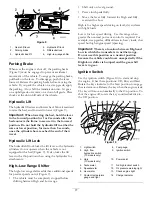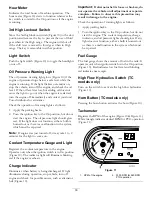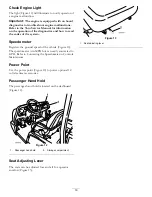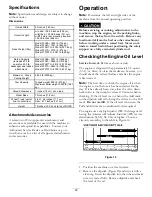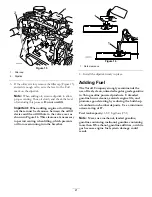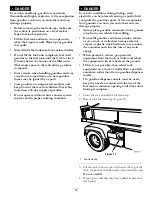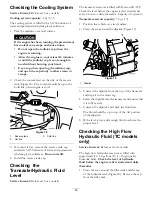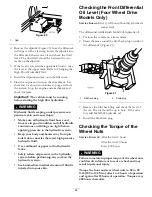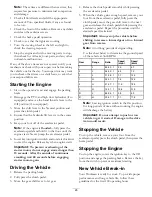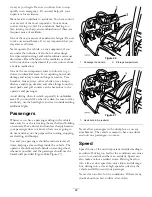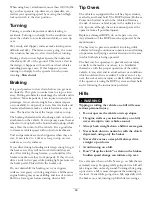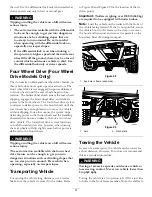
When using heavy attachments, more than 1000 lb (454
kg), such as sprayers, top dressers, or spreaders, etc.,
restrict your operating speed by moving the 3rd high
lockout switch to the slow position.
Turning
Turning is another important variable leading to
accidents. Turning too sharply for the conditions can
cause the vehicle to lose traction and skid, or even tip
over.
Wet, sandy, and slippery surfaces make turning more
difficult and risky. The faster you are going, the worse
this situation becomes so, slow down before turning.
During a sharp turn at higher speeds, the inside rear
wheel may lift off of the ground. This is not a flaw in
the design, it happens with most four wheel vehicles
including passenger cars. If this happens, you are
turning too sharply for the speed at which you are
traveling.
Slow down!
Braking
It is good practice to slow down before you get near
an obstacle. This gives you extra time to stop or turn
away. Hitting an obstacle can damage the vehicle and its
contents. More important, it can injure you and your
passenger. Gross vehicle weight has a major impact
on your ability to stop and/or turn. Heavier loads and
heavier attachments make a vehicle harder to stop or
turn. The heavier the load, the longer it takes to stop
The braking characteristics also change with no bed or
attachment on the vehicle. Fast stops may cause the rear
wheels to lock up before the front wheels lock up, which
may affect the control of the vehicle. It is a good idea
to decrease vehicle speed with no bed or attachment.
Turf and pavement are much slipperier when they are
wet. It can take 2 to 4 times as long to stop on wet
surfaces as on dry surfaces.
If you drive through standing water deep enough to get
the brakes wet, they will not work well until they are
dry. After driving through water, you should test the
brakes to make sure they work properly. If they do not,
drive slowly in first gear while putting light pressure on
the brake pedal. This will dry the brakes out.
Do not downshift for braking on icy or slippery
surfaces (wet grass) or while going down a hill because
engine braking may cause skidding and loss of control.
Shift to a lower gear before starting down a hill.
Tip Overs
The vehicle is equipped with a roll bar, hip restraints,
seat belts, and hand hold. The ROPS system (Rollover
Protection System) used on the vehicle will reduce
the risk of serious or fatal injury in the unlikely event
of a tip over, although the system cannot protect the
operator from all possible injuries.
Replace a damaged ROPS, do not repair or revise.
Any alteration of the ROPS must be approved by the
manufacturer.
The best way to prevent accidents involving utility
vehicles is through continuous supervision and training
of operators and paying constant attention to the area
in which vehicle is being operated.
The best way for operators to prevent serious injury
or death to themselves or others, is to familiarize
themselves with the proper operation of the utility
vehicle, to stay alert and to avoid actions or conditions
which could result in a accident. In the event of a tip
over, the risk of serious injury or death will be reduced
if the operator is using the ROPS system and seat belts
and is following the instructions provided.
Hills
WARNING
Tipping or rolling the vehicle on a hill will cause
serious personal injury.
•
Do not operate the vehicle on steep slopes.
•
If engine stalls or you lose headway on a hill,
never attempt to turn vehicle around.
•
Always back straight down a hill in reverse gear.
•
Never back down in neutral or with the clutch
depressed, using only the brakes.
•
Never drive across a steep hill, always drive
straight up or down.
•
Avoid turning on a hill.
•
Don’t “drop the clutch” or slam on the brakes.
Sudden speed change can initiate a tip over.
Use extra care when on hills. Never go on hills that are
extremely steep. Stopping while going down a hill will
take longer than on level ground. Turning while going
up or down a hill is more dangerous than turning on
the level. Turns while going down hill, especially with
the brakes on, and, turning up hill while traversing a
29
Summary of Contents for 07367TC
Page 41: ...Figure 44 41...
Page 60: ...Schematics Hydraulic Schematic Rev B High Flow Hydraulics Schematic TC models only Rev A 60...
Page 61: ...Electrical Schematic Rev B 61...
Page 62: ...Notes 62...
Page 63: ...Notes 63...



